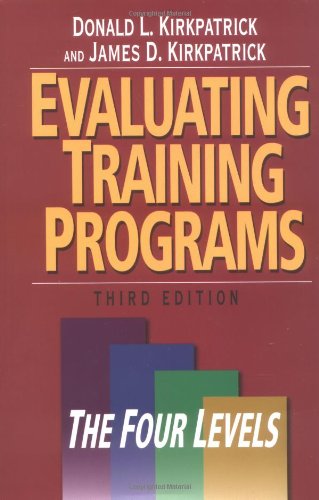Evaluating Training Programs: The Four Levels download
Par rodrigues victoria le lundi, décembre 7 2015, 21:27 - Lien permanent
Evaluating Training Programs: The Four Levels by Donald L Kirkpatrick


Download eBook
Evaluating Training Programs: The Four Levels Donald L Kirkpatrick ebook
Format: pdf
Page: 399
Publisher: Berrett-Koehler Publishers
ISBN: 1576753484,
We are pleased to share the How do we create an effective training program when resources are limited and yet we must cater to different groups and levels of people in an organization? To what degree participants apply what they learned during training when they are back on the job. The program's mission is to develop capacity and leadership to optimize the use of research-based evidence in Canadian healthcare organizations. The "Kirkpatrick Model" for evaluating training programs is the most widely used approach in the corporate, government, and academic worlds. I feel that these four criteria are good places to evaluate the success of a training program, especially when the training programs are administered in a business/workplace environment. Self-efficacy is an important outcome from any training program as it reflects participants' ability to translate acquired skills into day-to-day clinical practice [36,54]. Another model and I' ve been critical of the use of ROI in casual conversation to lead others to believe that we have an organizations best interests at heart as we assess, design, deliver, and evaluate training programs. My article was “Donald L Kirkpatrick's training evaluation model – the four levels of learning evaluation”, which talked about the evaluation theories of Donald L Kirkpatrick's, Professor Emeritus, University Of Wisconsin. Kirkpatrick's Revised Four Level Evaluation Model. In the Judicial sector, where these incentives may not be present, it may be more difficult to obtain an adequate response to the three levels of evaluation (pre-training, post training and follow-up) that are recommended 4 interactive web site that includes information about the trainings as well as the evaluation instruments which can be filled out on line prior to the training sessions, right after the sessions and as a follow-up six months later. Completion of training courses. Evaluate training programs not only immediately but long-term (6, 12, 18 months). Each table discussed one of four major questions and noted the key lessons drawn from the presentation as well as from the practical experiences of participants. Paraprofessionals known as Program Representatives provide the day-to-day operations for programming at the local level. I had an interesting discussion with Clark Quinn on using Kirkpatrick's model in learning processes other than courses. Level 4: Results To what degree targeted outcomes occur as a result of the training event and subsequent reinforcement. Kirkpatrick established a change in the trainee's performance.
Boundary and Eigenvalue Problems in Mathematical Physics. pdf
Numerical Methods, Algorithms and Tools in C' epub